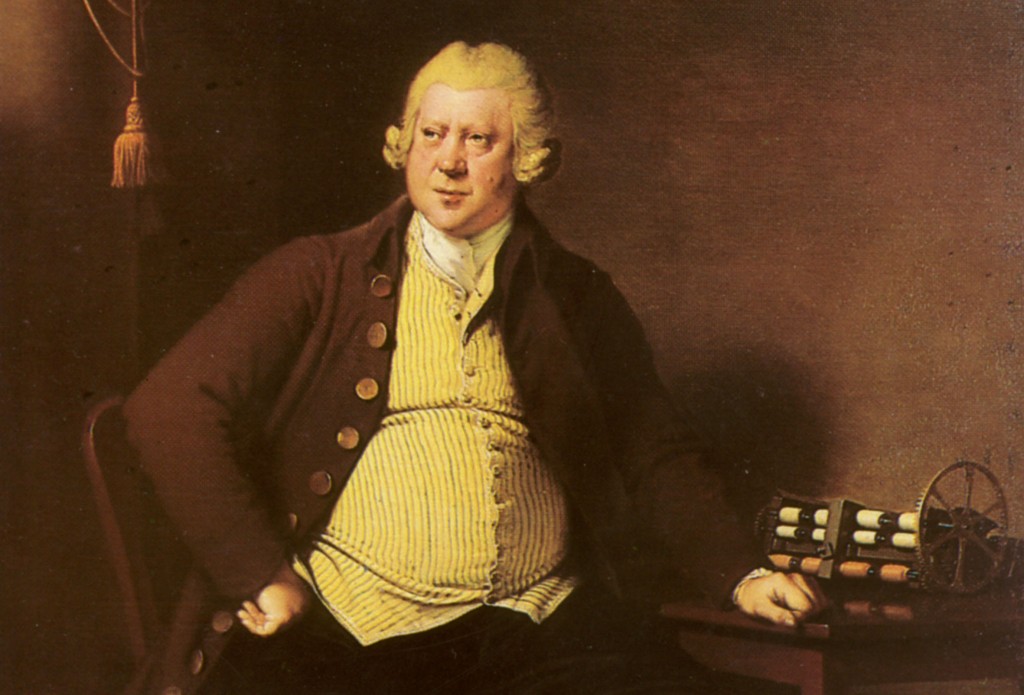Key Figures – Richard Arkwright

Key Figures – Richard Arkwright 1732-92
Richard Arkwright was born in Preston the son of Thomas Arkwright, a tailor. He received little formal education and his parents apprenticed him to a barber. He then moved to Bolton where he worked for a peruke maker, later setting up on his own. In 1755 he married his first wife, Patience Holt, and at the end of that year their son Richard was born. By the early 1760s Richard Arkwright was running a barber’s shop, a public house and making wigs, for which purpose he travelled the country to buy women’s hair. It was during this period he began to experiment with machinery to spin cotton. About 1764 or 1765, he met Thomas Highs and John Kay and, over the next three years, struggling against poverty – he had given up all employment to spend time on his experiments – he finally completed his work while living in the schoolmaster’s house in Preston. In the spring of 1768 Richard Arkwright left Preston for Nottingham, seeking backers who would finance a patent and further develop his machine. Ultimately he was successful both with his patent and in securing men of substance in the form of Samuel Need and Jedediah Strutt to fund his mills in Nottingham and Cromford. By 1775, Arkwright’s contribution to technological development was complete and the systems he devised to mechanise the pre-spinning preparatory processes were embodied in his second patent of 1775. At the trial where Arkwright’s patent was finally set aside in 1785, much was made of his dependence on others or, more bluntly, his theft of the machine he claimed to have invented. Doubts about Richard Arkwright’s integrity as an inventor have persisted. Even in 1932 when Richard Arkwright’s bicentenary was being celebrated, the Manchester Guardian, in a long adulatory piece, could find no way round confessing the man was probably a thief. More recently, research by Dr Richard Hills has exposed the weakness in this interpretation: the machines Arkwright is alleged to have copied contained fundamental flaws and could never have been made to work. Thus Arkwright’s reputation as an inventor has been restored to him. To Arkwright the inventor must be added Arkwright the production manager. When contemporaries wrote of the Arkwright System it was not simply a set of machines they had in mind. The Arkwright System integrated the machinery and the workforce around a common source of motive power. After the second patent and the second Cromford Mill, Arkwright’s empire grew, both by building mills which were run by his extended family or by managers who had learned their trade at Cromford and by licensed use of the machinery. Arkwright became immensely rich and began to enjoy his wealth. In 1786 he received a knighthood and in the same year began to build a mansion in Cromford, Willersley Castle. In 1788 while the Castle was being built Arkwright bought himself a town house, 8 Adam Street. He also had his portrait painted by Joseph Wright of Derby and by an American artist, Mather Brown. But if he acquired the trappings of gentility he never felt the need to live the life of a country gentleman. It is said that even “when considerably more than 50 years of age – feeling that the defects of his education placed him under great difficulty and inconvenience in conducting his correspondence, and in the general management of his business – he encroached upon his sleep, in order to gain an hour each day to learn English grammar and another hour to improve his writing and orthography”.
Wedgwood also presents a picture of a man driven by his business affairs. “I have visited Mr Arkwright several times and find him much more conversible than I expected, and he invites me to come and see as often as I can, though he tells me he at present shuns all company as much as possible because it robs him of his time and breaks in upon his plans – and besides he says he is no company for them, for whilst they are talking to him upon one subject he is thinking upon another, and does not know what they say to him”. Sir Richard was reported by the Gentleman’s Magazine as having “died immensely rich, and [as having] left manufactories the income of which is greater than that of most German principalities… his real and personal property is estimated at little short of half a million”. In an obituary in the Derby Mercury Erasmus Darwin adopted a wider perspective. Arkwright’s system of spinning “by giving perpetual employment to many thousand families has increased the population, and been productive of greater commercial advantages to this country, and contributed more to the general benefit of mankind, in so short a period of time, than any other single effort of human ingenuity”.

